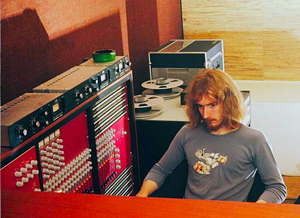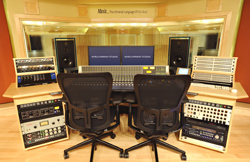 I owe a debt to conversations I have had with recording studio designers.
I owe a debt to conversations I have had with recording studio designers.
Their work requires them to be expert in an unusually wide number of fields – from the obvious areas of acoustics and equipment, to interior design and psychology. Add music biz anecdotes, and many would make great after-dinner speakers. It was a studio designer who put me wise to the problem of a ‘good enough’ audio chain.
Before he left the UK to establish a new base in Spain – where he put a new slant on his studio design and other acoustic design work – Philip Newell was involved in some significant projects at UK recording facilities, including Virgin Records’ groundbreaking Manor Mobile.
Linked in, losing out
Along with American designer Tom Hidley, Phil chose to regard control room acoustics and monitoring systems as a single, integrated system, championing the ‘non-environment’ approach to design. Earlier, as Virgin’s Technical Director, he was the driving force behind the UK’s first 24-track mobile recording truck – also the first in Europe, according to former Manor Mobile recording engineer Chris Hollebone’s recollection.

Today, his rigorous understanding of loudspeaker design and control room acoustics make his published work reference reading (look up 2003’s Recording Studio Design). And he continues to deliver studios that draw on this heritage to owners who frequently can’t believe their luck. So he was not to be taken lightly when he offered me his opinions on the impact of early digital recorders on the quality of recorded audio.
In short – and unsurprisingly – they rang alarm bells. But Phil’s concern wasn’t simply a knee-jerk defensive reaction from the old school. As ever, his eye was on the whole audio chain, and what was happening to it.
In fact, Phil wrote several articles for Studio Sound magazine (while I was editor) in an attempt to win others over to sharing his concerns.
He likened the complete recording path to a chain, with the weakest link determining the highest achievable quality, whether that was a patchcord, the target recorder or the performance of the monitoring loudspeakers. He also took into account equipment reliability and the meagre support services offered by some manufacturers and distributors. Especially when it came to live location recording.
So much of Phil’s philosophy seems distant at a time when a high proportion of music is made using laptop computers and cheap soundcards in makeshift rooms with badly placed loudspeakers – and kids (of all ages) listen to it on mobile phones and MP3 players. Weakest Link? The whole damn chain looks so fragile…
Good enough
Central to Phil’s frustration was the growing practice of making things ‘good enough’. As long as the performance of any single link in the recording chain was even marginally better than some other link, it was ‘good enough’.
Indeed it was, if you adopted a very selective and short-term perspective. But ‘good enough’ was often a temporary state of affairs that saw poorly specified or supported equipment swapping places like football teams in the relegation zone of the league, or F1 drivers in qualifying.
There’s a loose and fallacious analogy to be made with ‘JIT’ manufacturing – why keep parts and materials when you can order them ‘just in time’ to use them? JIT directly reduces storage and advance purchasing by making the supply chain just good enough to keep manufacture flowing.
But once manufactured, the goods are on their way, built to the required standard and passed by whatever QC is in place. A recording studio – high-end, project, static, fly-away, mobile or any other – runs on its kit and facilities. Upgrades and additions should not be made in fear of exposing poor performance or failings elsewhere in the studio.
Old school, new church
It is interesting, then, to see an altogether different trend developing in some of the news hitting the pro audio press. After the decimation of the high-end recording market, there looks to be a resurgence of studios that echo Newell’s love of audio quality and revive other aspects of big room recording’s heyday.

Among those already mentioned on Fast-and-Wide are New York City’s Jungle City Studios, Blade Studios in Lousiana, Pittsboro’s Manifold Recording, Green Road Studio in Costa Rica and Roma & Romma Records in Venzuela. (Are there others that we have missed?) The latest facility to join the party is Sam Nappi’s impressive World Harmony Studios in Upstate New York, designed by John Storyk.
Unless this is some form of audiophile-seeking mass hysteria, there is something good happening here.
The dust has now settled on the collapse of the old order of international studios. Project rooms – along with project kit, project working and project frustrations – have burned in and lost some of their lustre. And many of the old school ways appear to be regaining their appeal.
Travelling further than your front door to a facility equipped with well maintained equipment and reliable monitoring can bring a lot to a recording project. Especially if the facility has arranged its pricing to fit the present shabby state of the music biz.
If the response to these stories appearing on Fast-and-Wide is at all representative, they are receiving a welcome that borders on expectation – as if the reinstatement of the ‘professional’ advantage in recording facilities is a return to a natural order.
Now we have to see if there can be a similar recovery in the world of hi-fi…

